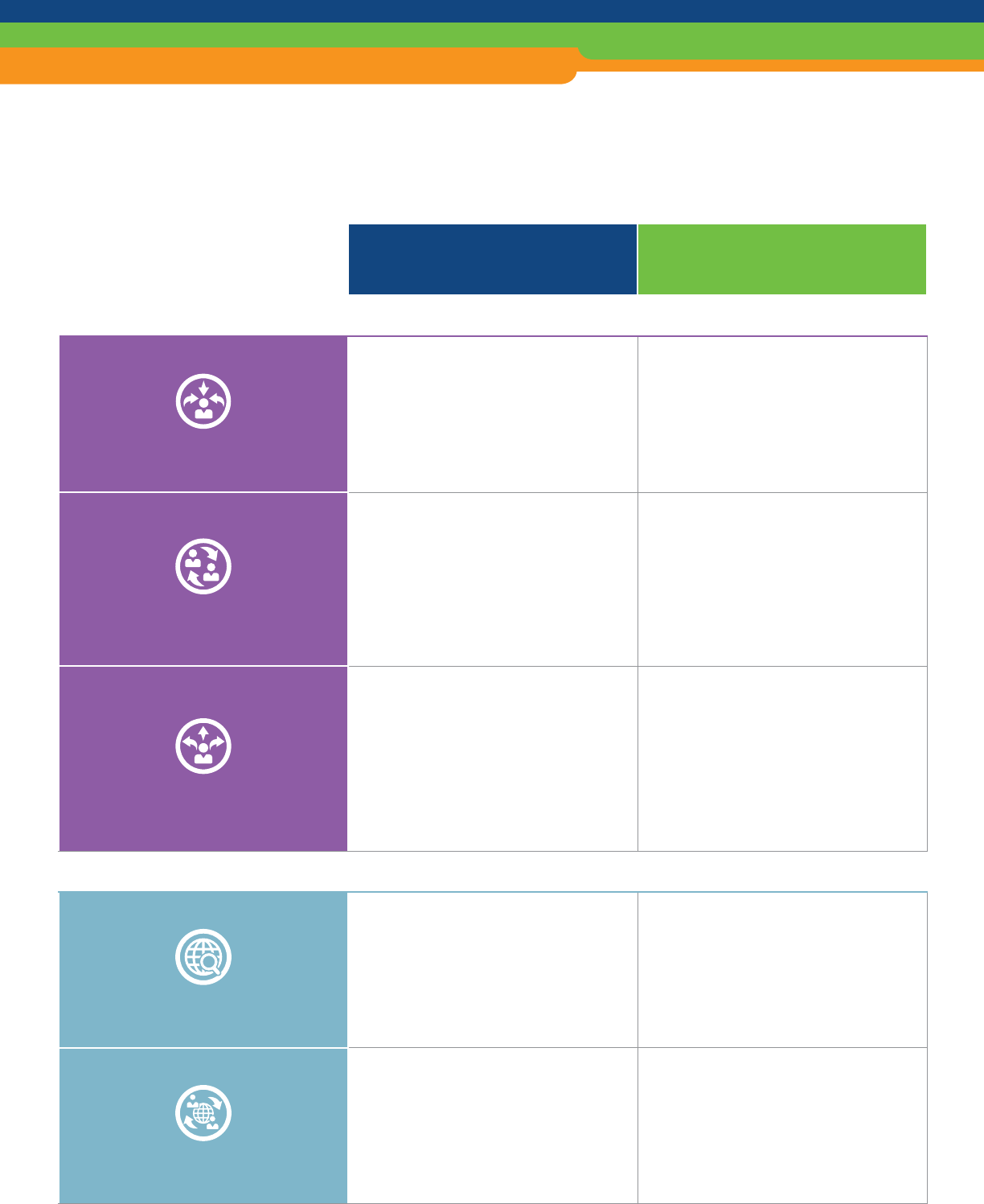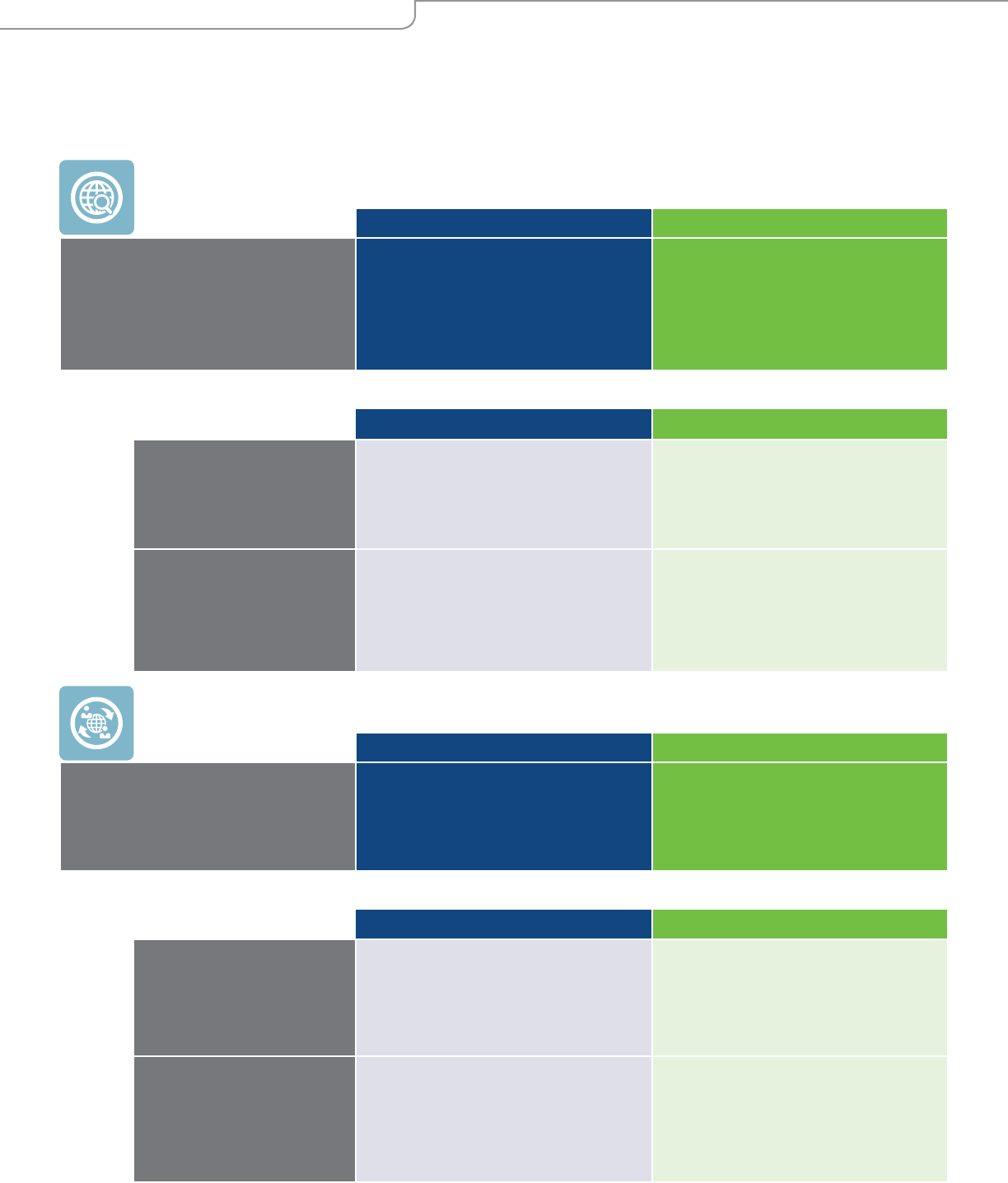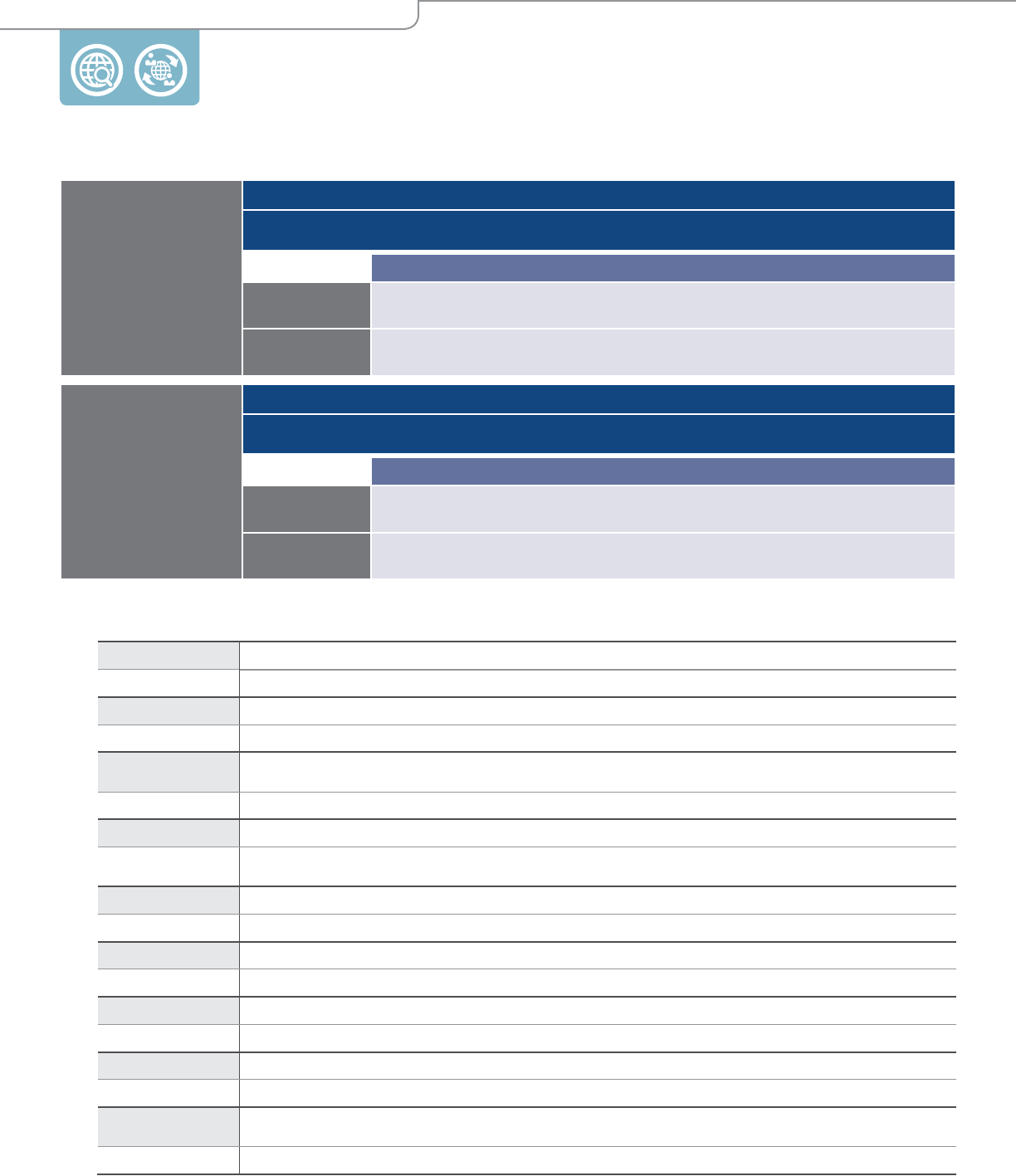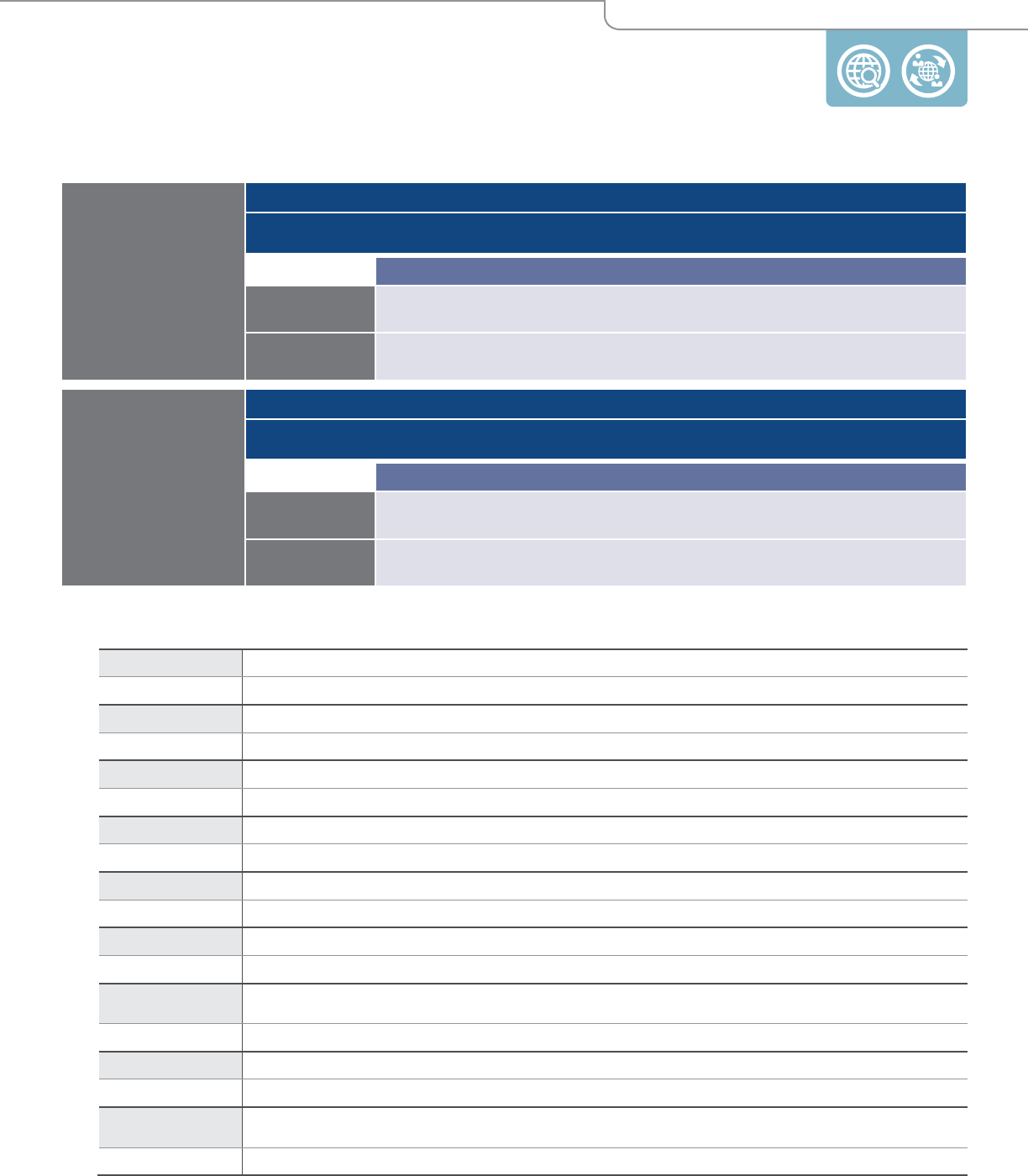
NCSSFL-ACTFL CAN-DO STATEMENTS: PERFORMANCE INDICATORS FOR LANGUAGE LEARNERS © 2017 1
NOVICE
PROFICIENCY BENCHMARK
INTERMEDIATE
PROFICIENCY BENCHMARK
ADVANCED
PROFICIENCY BENCHMARK
SUPERIOR
PROFICIENCY BENCHMARK
DISTINGUISHED
PROFICIENCY BENCHMARK
COMMUNICATION COMMUNICATION
INTERPRETIVE
I can identify the general topic and
some basic information in both very
familiar and everyday contexts by
recognizing practiced or memorized
words, phrases, and simple sentences in
texts that are spoken, written, or signed.
I can understand the main idea and
some pieces of information on familiar
topics from sentences and series of
connected sentences within texts that are
spoken, written, or signed.
I can understand the main message
and supporting details on a wide
variety of familiar and general interest
topics across various time frames from
complex, organized texts that are
spoken, written, or signed.
I can interpret and infer meaning from
complex, academic and professional
texts on a range of unfamiliar,
abstract, and specialized issues that
are spoken, written, or signed.
I can interpret and infer meaning
from dense, structurally sophisticated
texts on a wide range of global issues
and highly abstract concepts, with
deeply embedded cultural references
and colloquialisms and dialects that
are spoken, written, or signed.
INTERPRETIVE
INTERPERSONAL
I can communicate in spontaneous
spoken, written, or signed conversations
on both very familiar and everyday
topics, using a variety of practiced or
memorized words, phrases, simple
sentences, and questions.
I can participate in spontaneous spoken,
written, or signed conversations on
familiar topics, creating sentences and
series of sentences to ask and answer a
variety of questions.
I can maintain spontaneous spoken,
written, or signed conversations and
discussions across various time frames
on familiar, as well as unfamiliar,
concrete topics, using series of
connected sentences and probing
questions.
I can participate fully and effectively
in spontaneous spoken, written,
or signed discussions and debates
on issues and ideas ranging from
broad general interests to my areas
of specialized expertise, including
supporting arguments and exploring
hypotheses.
I can interact, negotiate, and debate
on a wide range of global issues
and highly abstract concepts, fully
adapting to the cultural context of the
conversation, using spoken, written, or
signed language.
INTERPERSONAL
PRESENTATIONAL
I can present information on both very
familiar and everyday topics using a
variety of practiced or memorized words,
phrases, and simple sentences through
spoken, written, or signed language.
I can communicate information, make
presentations, and express my thoughts
about familiar topics, using sentences
and series of connected sentences
through spoken, written, or signed
language.
I can deliver detailed and organized
presentations on familiar as well
as unfamiliar concrete topics, in
paragraphs and using various time
frames through spoken, written, or
signed language.
I can deliver extended presentations
on abstract or hypothetical issues and
ideas ranging from broad general
interests to my areas of specialized
expertise, with precision of expression
and to a wide variety of audiences,
using spoken, written, or signed
language.
I can deliver sophisticated and
articulate presentations on a wide
range of global issues and highly
abstract concepts, fully adapting to the
cultural context of the audience, using
spoken, written, or signed language.
PRESENTATIONAL
INTERCULTURAL COMMUNICATION INTERCULTURAL COMMUNICATION
INVESTIGATE
In my own and other cultures I can
identify products and practices to help
me understand perspectives.
In my own and other cultures I can
make comparisons between products
and practices to help me understand
perspectives.
In my own and other cultures
I can explain some diversity among
products and practices and how it
relates to perspectives.
In my own and other cultures I can
suspend judgment while critically
examining products, practices, and
perspectives.
In my own and other cultures I can
objectively evaluate products and
practices and mediate perspectives.
INVESTIGATE
INTERACT
I can interact at a survival level in some
familiar everyday contexts.
I can interact at a functional level in
some familiar contexts.
I can interact at a competent level in
familiar and some unfamiliar contexts.
I can interact in complex situations
to ensure a shared understanding of
culture.
I can engage with complexity and
pluricultural identities and serve as
a mediator between and among
cultures.
INTERACT
NCSSFL-ACTFL CAN-DO STATEMENTS
PROFICIENCY BENCHMARKS

NCSSFL-ACTFL CAN-DO STATEMENTS: PERFORMANCE INDICATORS FOR LANGUAGE LEARNERS © 2017 2
INTERPRETIVE COMMUNICATION
PROFICIENCY BENCHMARKS + PERFORMANCE INDICATORS
PROFICIENCY BENCHMARK
I can identify the general topic and some basic information in both very familiar and everyday contexts by recognizing practiced or
memorized words, phrases, and simple sentences in texts that are spoken, written, or signed.
What can I understand, interpret or analyze
in authentic informational texts that I hear, read or view?
PERFORMANCE INDICATORS
NOVICE LOW NOVICE MID NOVICE HIGH
I can identify memorized or familiar
words when they are supported by
gestures or visuals in informational texts.
I can identify some basic facts from
memorized or familiar words and
phrases when they are supported by
gestures or visuals in informational texts.
I can identify the topic and some
isolated facts from simple sentences in
informational texts.
What can I understand, interpret or analyze
in authentic fi ctional texts that I hear, read or view?
PERFORMANCE INDICATORS
NOVICE LOW NOVICE MID NOVICE HIGH
I can identify memorized or familiar
words when they are supported by
gestures or visuals in fi ctional texts.
I can identify some basic facts from
memorized or familiar words and
phrases when they are supported by
gestures or visuals in fi ctional texts.
I can identify the topic and some
isolated elements from simple sentences
in short fi ctional texts.
What can I understand, interpret or analyze in conversations and discussions
that I hear, read or view, in which I am not a participant?
PERFORMANCE INDICATORS
NOVICE LOW NOVICE MID NOVICE HIGH
I can understand memorized or familiar
words when they are supported by
gestures or visuals in conversations.
I can identify some basic facts from
memorized or familiar words and
phrases when they are supported by
gestures or visuals in conversations.
I can understand familiar questions
and statements from simple sentences in
conversations.
NOVICE
What elements of literacy lead to higher levels of understanding in the Interpretive Mode?
Learners move along the profi ciency continuum at different speeds in listening, reading or viewing. Learners bring prior skills and experience in L1 and L2 to the
Interpretive mode. Factors that impact how well learners understand texts include:
a) text complexity or length
b) familiarity with topic and background knowledge
c) ability to use literacy strategies such as recognizing key words, detecting the main idea, identifying supporting details, noting organizational features, guessing
meaning from context, identifying logical inferences, identifying the author’s perspective and cultural perspectives/norms.
NCSSFL-ACTFL CAN-DO STATEMENTS NCSSFL-ACTFL CAN-DO STATEMENTS

NCSSFL-ACTFL CAN-DO STATEMENTS: PERFORMANCE INDICATORS FOR LANGUAGE LEARNERS © 2017 3
INTERPERSONAL COMMUNICATION
PROFICIENCY BENCHMARKS + PERFORMANCE INDICATORS
PROFICIENCY BENCHMARK
I can communicate in spontaneous spoken, written, or signed conversations on both very familiar and everyday topics, using a
variety of practiced or memorized words, phrases, simple sentences, and questions.
How can I exchange information and ideas
in conversations?
PERFORMANCE INDICATORS
NOVICE LOW NOVICE MID NOVICE HIGH
I can provide information by answering
a few simple questions on very familiar
topics, using practiced or memorized
words and phrases, with the help of
gestures or visuals.
I can request and provide information
by asking and answering a few simple
questions on very familiar and everyday
topics, using a mixture of practiced or
memorized words, phrases, and simple
sentences.
I can request and provide information
by asking and answering practiced and
some original questions on familiar and
everyday topics, using simple sentences
most of the time.
How can I meet my needs or address situations
in conversations?
PERFORMANCE INDICATORS
NOVICE LOW NOVICE MID NOVICE HIGH
I can express some basic needs, using
practiced or memorized words and
phrases, with the help of gestures or
visuals.
I can express basic needs related to
familiar and everyday activities, using
a mixture of practiced or memorized
words, phrases, simple sentences,
and questions.
I can interact with others to meet my
basic needs related to routine everyday
activities, using simple sentences and
questions most of the time.
How can I express, react to, and support preferences and opinions
in conversations?
PERFORMANCE INDICATORS
NOVICE LOW NOVICE MID NOVICE HIGH
I can express basic preferences or
feelings, using practiced or memorized
words and phrases, with the help of
gestures or visuals.
I can express my own preferences
or feelings and react to those of
others, using a mixture of practiced
or memorized words, phrases, simple
sentences, and questions.
I can express, ask about, and react to
preferences, feelings, or opinions on
familiar topics, using simple sentences
most of the time and asking questions to
keep the conversation on topic.
NOVICE
NCSSFL-ACTFL CAN-DO STATEMENTS

NCSSFL-ACTFL CAN-DO STATEMENTS: PERFORMANCE INDICATORS FOR LANGUAGE LEARNERS © 2017 4
PRESENTATIONAL COMMUNICATION
PROFICIENCY BENCHMARKS + PERFORMANCE INDICATORS
PROFICIENCY BENCHMARK
I can present information on both very familiar and everyday topics using a variety of practiced or memorized words, phrases, and
simple sentences through spoken, written, or signed language.
How can I present information to
narrate about my life, experiences and events?
PERFORMANCE INDICATORS
NOVICE LOW NOVICE MID NOVICE HIGH
I can introduce myself using practiced or
memorized words and phrases, with the
help of gestures or visuals.
I can present information about myself,
my interests and my activities using
a mixture of practiced or memorized
words, phrases and simple sentences.
I can present personal information
about my life and activities, using simple
sentences most of the time.
How can I present information to
give a preference, opinion or persuasive argument?
PERFORMANCE INDICATORS
NOVICE LOW NOVICE MID NOVICE HIGH
I can express my likes and dislikes
using practiced or memorized words
and phrases, with the help of gestures or
visuals.
I can express my likes and dislikes on
very familiar and everyday topics of
interest, using a mixture of practiced or
memorized words, phrases and simple
sentences
I can express my preferences on familiar
and everyday topics of interest, using
simple sentences most of the time.
How can I present information
to inform, describe, or explain?
PERFORMANCE INDICATORS
NOVICE LOW NOVICE MID NOVICE HIGH
I can name very familiar people,
places, and objects using practiced or
memorized words and phrases, with the
help of gestures or visuals.
I can present on very familiar and
everyday topics using a mixture of
practiced or memorized words, phrases
and simple sentences.
I can present on familiar and everyday
topics, using simple sentences most of the
time.
NOVICE
NCSSFL-ACTFL CAN-DO STATEMENTS NCSSFL-ACTFL CAN-DO STATEMENTS

NCSSFL-ACTFL CAN-DO STATEMENTS: PERFORMANCE INDICATORS FOR LANGUAGE LEARNERS © 2017 5
INTERCULTURAL COMMUNICATION
PROFICIENCY BENCHMARKS + PERFORMANCE INDICATORS
NOVICE INTERMEDIATE
PROFICIENCY BENCHMARK PROFICIENCY BENCHMARK
INVESTIGATE
Investigate Products And Practices
To Understand Cultural Perspectives
In my own and other cultures I can
identify products and practices to help
me understand perspectives.
In my own and other cultures I can
make comparisons between products
and practices to help me understand
perspectives.
PERFORMANCE INDICATORS PERFORMANCE INDICATORS
PRODUCTS
In my own and other cultures I can
identify some typical products related to
familiar everyday life.
In my own and other cultures I can
compare products related to everyday
life and personal interests or studies.
PRACTICES
In my own and other cultures I can
identify some typical practices related to
familiar everyday life.
In my own and other cultures I can
compare practices related to everyday
life and personal interests or studies.
PROFICIENCY BENCHMARK PROFICIENCY BENCHMARK
INTERACT
Interact With Others In And From
Another Culture
I can interact at a survival level in some
familiar everyday contexts.
I can interact at a functional level in
some familiar contexts.
PERFORMANCE INDICATORS PERFORMANCE INDICATORS
LANGUAGE
I can communicate with others from
the target culture in familiar everyday
situations, using memorized language
and showing basic cultural awareness.
I can converse with peers from the target
culture in familiar situations at school,
work, or play, and show interest in basic
cultural similarities and differences.
BEHAVIOR
I can use appropriate rehearsed
behaviors and recognize some obviously
inappropriate behaviors in familiar
everyday situations.
I can recognize that signifi cant
differences in behaviors exist among
cultures, use appropriate learned
behaviors and avoid major social
blunders.
NCSSFL-ACTFL CAN-DO STATEMENTS NCSSFL-ACTFL CAN-DO STATEMENTS

NCSSFL-ACTFL CAN-DO STATEMENTS: PERFORMANCE INDICATORS FOR LANGUAGE LEARNERS © 2017 6
INTERPRETIVE COMMUNICATION
PROFICIENCY BENCHMARKS + PERFORMANCE INDICATORS + EXAMPLES
PROFICIENCY BENCHMARK
I can identify the general topic and some basic information in both very familiar and everyday contexts by recognizing practiced or
memorized words, phrases, and simple sentences in texts that are spoken, written, or signed.
What can I understand, interpret or analyze
in authentic informational texts that I hear, read or view?
PERFORMANCE INDICATORS
NOVICE LOW NOVICE MID NOVICE HIGH
I can identify memorized or familiar
words when they are supported by
gestures or visuals in informational texts.
I can identify some basic facts from
memorized or familiar words and
phrases when they are supported by
gestures or visuals in informational texts.
I can identify the topic and some
isolated facts from simple sentences in
informational texts.
EXAMPLES: Written
NOVICE LOW NOVICE MID NOVICE HIGH
I can… (customize with specifi c content).
I can identify some locations or stores by their
signs.
I can match a word or character in a headline to a
supporting visual.
I can recognize some names of cities on a map.
I can identify labeled aisles in a store.
I can recognize the labels on a recycling bin.
I can… (customize with specifi c content).
I can identify nutritional categories on food labels.
I can identify names of classes and their locations
on a class schedule.
I can identify my departure and arrival times from a
transportation schedule.
I can understand what information is provided on a
student ID card.
I can understand subject-specifi c terms on a word
wall.
I can… (customize with specifi c content).
I can follow directions in a Scavenger Hunt game
I can understand a variety of simple messages on
greeting cards.
I can select a movie based on a short description.
I can understand someone’s profi le on a social
media site.
I can understand some facts about the weather
especially when weather symbols are used.
EXAMPLES: Spoken, Viewed or Signed
NOVICE LOW NOVICE MID NOVICE HIGH
I can… (customize with specifi c content).
I can recognize familiar names of people and places
in a public announcement.
I can understand simple directions to a familiar
place.
I can follow instructions for simple class routines.
I can understand names and titles when speakers
are introduced.
I can understand a cell phone number.
I can… (customize with specifi c content).
I can understand the time announced for a store
closing.
I can understand directions for setting the table.
I can follow directions to fi ll out a simple graphic
organizer.
I can understand the names of the planets in a
science class.
I can recognize some weather expressions in a
forecast.
I can… (customize with specifi c content).
I can understand the name of a product, the cost,
and where to buy it from a radio ad.
I can understand who to pick up and where to take
them from a friend’s voicemail.
I can follow a YouTube video on how to play a
simple game.
I can understand an emergency alert during a TV
show.
I can understand when a sports announcer
introduces the team players.
NOVICE
What elements of literacy lead to higher levels of understanding in the Interpretive Mode?
Learners move along the profi ciency continuum at different speeds in listening, reading or viewing. Learners bring prior skills and experience in L1 and L2 to the
Interpretive mode. Factors that impact how well learners understand texts include: a) text complexity or length; b) familiarity with topic and background knowledge;
and c) ability to use literacy strategies such as recognizing key words, detecting the main idea, identifying supporting details, noting organizational features, guessing
meaning from context, identifying logical inferences, identifying the author’s perspective and cultural perspectives/norms.
NCSSFL-ACTFL CAN-DO STATEMENTS NCSSFL-ACTFL CAN-DO STATEMENTS

NCSSFL-ACTFL CAN-DO STATEMENTS: PERFORMANCE INDICATORS FOR LANGUAGE LEARNERS © 2017 7
INTERPRETIVE COMMUNICATION
PROFICIENCY BENCHMARKS + PERFORMANCE INDICATORS + EXAMPLES
NOVICE
PROFICIENCY BENCHMARK
I can identify the general topic and some basic information in both very familiar and everyday contexts by recognizing practiced or
memorized words, phrases, and simple sentences in texts that are spoken, written, or signed.
What can I understand, interpret or analyze
in authentic fi ctional texts that I hear, read or view?
PERFORMANCE INDICATORS
NOVICE LOW NOVICE MID NOVICE HIGH
I can identify memorized or familiar
words when they are supported by
gestures or visuals in fi ctional texts.
I can identify some basic facts from
memorized or familiar words and
phrases when they are supported by
gestures or visuals in fi ctional texts.
I can identify the topic and some
isolated elements from simple sentences
in short fi ctional texts.
EXAMPLES: Written
NOVICE LOW NOVICE MID NOVICE HIGH
I can… (customize with specifi c content).
I can recognize a few individual written words in
the title of a story.
I can recognize a few individual written words in a
picture book.
I can recognize a few individual words in a poem.
I can recognize a character’s’ name in a folk tale.
I can recognize common opening and closing words
of a fairy tale.
I can… (customize with specifi c content).
I can identify some phrases describing a character
in a story.
I can identify some phrases in captions from
pictures in a book.
I can recognize a familiar memorized line from a
poem.
I can recognize some events from a story timeline.
I can recognize a song’s common one-line refrain.
I can… (customize with specifi c content).
I can identify the topic of a short story.
I can identify the topic of a poem.
I can identify some of the events in a fairy tale.
I can identify some of the traits of a superhero as
described in a comic book.
I can identify some actions described in a scene
from a play.
EXAMPLES: Spoken, Viewed or Signed
NOVICE LOW NOVICE MID NOVICE HIGH
I can… (customize with specifi c content).
I can recognize a few individual words of a read
aloud story.
I can recognize a few individual words in a read
aloud poem.
I can recognize a character’s name in a folk tale.
I can recognize common opening and closing words
in oral storytelling.
I can recognize a few familiar words from a music
video.
I can… (customize with specifi c content).
I can identify some phrases describing a character
in a story.
I can identify some phrases from a read aloud story.
I can recognize a familiar memorized line from a
poem.
I can recognize some events from a cartoon.
I can recognize a song’s common one-line refrain.
I can… (customize with specifi c content).
I can identify where and when a read aloud story
takes place.
I can identify how to get to the next level when
playing a video game.
I can identify some of the events in a
videostreamed show.
I can identify some of the traits of a superhero
described in video comic books.
I can identify some actions described in a scene
from a movie.
What elements of literacy lead to higher levels of understanding in the Interpretive Mode?
Learners move along the profi ciency continuum at different speeds in listening, reading or viewing. Learners bring prior skills and experience in L1 and L2 to the
Interpretive mode. Factors that impact how well learners understand texts include: a) text complexity or length; b) familiarity with topic and background knowledge;
and c) ability to use literacy strategies such as recognizing key words, detecting the main idea, identifying supporting details, noting organizational features, guessing
meaning from context, identifying logical inferences, identifying the author’s perspective and cultural perspectives/norms.
NCSSFL-ACTFL CAN-DO STATEMENTS NCSSFL-ACTFL CAN-DO STATEMENTS

NCSSFL-ACTFL CAN-DO STATEMENTS: PERFORMANCE INDICATORS FOR LANGUAGE LEARNERS © 2017 8
INTERPRETIVE COMMUNICATION
PROFICIENCY BENCHMARKS + PERFORMANCE INDICATORS + EXAMPLES
PROFICIENCY BENCHMARK
I can identify the general topic and some basic information in both very familiar and everyday contexts by recognizing practiced or
memorized words, phrases, and simple sentences in texts that are spoken, written, or signed.
What can I understand, interpret or analyze in conversations and discussions
that I hear, read or view, in which I am not a participant?
PERFORMANCE INDICATORS
NOVICE LOW NOVICE MID NOVICE HIGH
I can understand memorized or familiar
words when they are supported by
gestures or visuals in conversations.
I can identify some basic facts from
memorized or familiar words and
phrases when they are supported by
gestures or visuals in conversations.
I can understand familiar questions
and statements from simple sentences in
conversations.
EXAMPLES: Written
NOVICE LOW NOVICE MID NOVICE HIGH
I can… (customize with specifi c content).
I can recognize names and titles in an email
introduction.
I can recognize familiar place names in a brochure.
I can recognize greetings and leave taking words
in an email.
I can recognize salutation words in a business
letter.
I can recognize question words in a text message.
I can… (customize with specifi c content).
I can recognize dates in an email message.
I can recognize very common abbreviations in a text
message.
I can recognize whether a correspondence is formal
or informal.
I can understand the time in a meeting request.
I can understand familiar directions on a mobile
app.
I can… (customize with specifi c content).
I can understand someone’s simple descriptions of
a photo on Instagram.
I can understand questions about class schedules
in a text message.
I can understand simple feedback on a homework
assignment.
I can understand simple questions about family in
correspondence among an e-pals.
I can understand simple questions in a chat room.
EXAMPLES: Spoken, Viewed or Signed
NOVICE LOW NOVICE MID NOVICE HIGH
I can… (customize with specifi c content).
I can recognize when greetings and leave-taking
are expressed.
I can recognize peoples’ names and their titles
when they are introduced.
I can recognize a few individual question words in a
conversation among visitors in school.
I can recognize familiar names of places discussed
on a tour.
I can understand simple words of praise by a
teacher to a student.
I can… (customize with specifi c content).
I can understand when someone asks a person’s
name.
I can recognize a time or date when plans for an
event are discussed.
I can recognize some common expressions when
people are discussing the weather.
I can understand simple instructions given by a
parent to a child on the playground.
I can understand the difference between a
spoken statement and question in peoples’
conversations.
I can… (customize with specifi c content).
I can sometimes understand to whom people are
directing their conversation.
I can understand someone’s simple descriptions of
a photo.
I can understand questions about someone’s social
schedule.
I can understand simple compliments given to a
hostess.
I can understand simple questions a guest asks
about family.
NOVICE
What elements of literacy lead to higher levels of understanding in the Interpretive Mode?
Learners move along the profi ciency continuum at different speeds in listening, reading or viewing. Learners bring prior skills and experience in L1 and L2 to the
Interpretive mode. Factors that impact how well learners understand texts include: a) text complexity or length; b) familiarity with topic and background knowledge;
and c) ability to use literacy strategies such as recognizing key words, detecting the main idea, identifying supporting details, noting organizational features, guessing
meaning from context, identifying logical inferences, identifying the author’s perspective and cultural perspectives/norms.
NCSSFL-ACTFL CAN-DO STATEMENTS NCSSFL-ACTFL CAN-DO STATEMENTS

NCSSFL-ACTFL CAN-DO STATEMENTS: PERFORMANCE INDICATORS FOR LANGUAGE LEARNERS © 2017 9
INTERPERSONAL COMMUNICATION
PROFICIENCY BENCHMARKS + PERFORMANCE INDICATORS + EXAMPLES
PROFICIENCY BENCHMARK
I can communicate in spontaneous spoken, written, or signed conversations on both very familiar and everyday topics, using a
variety of practiced or memorized words, phrases, simple sentences, and questions.
How can I exchange information and ideas
in conversations?
PERFORMANCE INDICATORS
NOVICE LOW NOVICE MID NOVICE HIGH
I can provide information by answering
a few simple questions on very familiar
topics, using practiced or memorized
words and phrases, with the help of
gestures or visuals.
I can request and provide information
by asking and answering a few simple
questions on very familiar and everyday
topics, using a mixture of practiced or
memorized words, phrases, and simple
sentences.
I can request and provide information
by asking and answering practiced and
some original questions on familiar and
everyday topics, using simple sentences
most of the time.
EXAMPLES: Speaking/Listening or Signing
NOVICE LOW NOVICE MID NOVICE HIGH
I can… (customize with specifi c content).
I can introduce myself when I meet people.
I can answer questions about who is in my family.
I can answer questions about my favorite weekend
activities.
I can respond to a basic math question using
numbers.
I can respond when asked to name the style of
music I am playing.
I can… (customize with specifi c content).
I can ask who, what, where, or when questions
about a party.
I can respond to a math question reciting a simple
mathematical operation (e.g., 2 times 3 is 6).
I can contribute to a conversation about music
styles by giving an example of a style I like.
I can share the time and date of an upcoming
community event.
I can interact with a partner to complete a “fi ll-in-
the-blank” worksheet in a science class.
I can… (customize with specifi c content).
I can exchange information about things to do in
my town.
I can exchange information about which classes are
harder or easier than others and why.
I can ask and respond to some simple questions
about a scientifi c infographic.
I can contribute to a conversation about a story by
identifying who, what, when, and where.
I can ask and answer questions about a job
opening.
EXAMPLES: Writing/Reading
NOVICE LOW NOVICE MID NOVICE HIGH
I can… (customize with specifi c content).
I can respond to personal questions such as my
name, age, or family in an online forum.
I can fi ll out an online form to provide my class
schedule.
I can fi ll in a chat box by answering who, what,
where and or when questions.
I can text a friend the time and day we plan to
meet.
I can respond to a text message that asks where I
am going.
I can… (customize with specifi c content).
I can ask and answer questions about school, food,
or hobbies in an online conversation.
I can text questions and answers about the type of
restaurant we plan to go to tonight.
I can respond to an e-invitation and ask questions
about the event.
I can write a post-it note in response to a
discussion question.
I can text a backroom chat response.
I can… (customize with specifi c content).
I can exchange information about what I do for fun
with an ePal.
I can exchange texts with a friend about local
music venues.
I can respond to an email about a sporting event I
attended.
I can write a response to an e-card greeting.
I can exchange information about the latest video
game in an online chat.
NOVICE
NCSSFL-ACTFL CAN-DO STATEMENTS NCSSFL-ACTFL CAN-DO STATEMENTS

NCSSFL-ACTFL CAN-DO STATEMENTS: PERFORMANCE INDICATORS FOR LANGUAGE LEARNERS © 2017 10
INTERPERSONAL COMMUNICATION
PROFICIENCY BENCHMARKS + PERFORMANCE INDICATORS + EXAMPLES
PROFICIENCY BENCHMARK
I can communicate in spontaneous spoken, written, or signed conversations on both very familiar and everyday topics, using a
variety of practiced or memorized words, phrases, simple sentences, and questions.
How can I meet my needs or address situations
in conversations?
PERFORMANCE INDICATORS
NOVICE LOW NOVICE MID NOVICE HIGH
I can express some basic needs, using
practiced or memorized words and
phrases, with the help of gestures or
visuals.
I can express basic needs related to
familiar and everyday activities, using
a mixture of practiced or memorized
words, phrases, simple sentences,
and questions.
I can interact with others to meet my
basic needs related to routine everyday
activities, using simple sentences and
questions most of the time.
EXAMPLES: Speaking/Listening or Signing
NOVICE LOW NOVICE MID NOVICE HIGH
I can… (customize with specifi c content).
I can tell someone my name.
I can greet and take leave in a polite way.
I can tell the customs offi cial which countries I
visited.
I can tell someone whether or not I understand
them.
I can say how much money I need to pay for my
lunch.
I can… (customize with specifi c content).
I can introduce someone else and ask related
questions.
I can say that I am hungry, cold, or tired and ask
others.
I can ask and answer questions about homework.
I can politely ask someone to repeat something I
did not understand.
I can ask and understand how much something
costs.
I can… (customize with specifi c content).
I can ask for directions when I’m lost.
I can interact with a partner to plan who will do
what for an upcoming project, and when.
I can exchange advice to choose an outfi t for an
event.
I can confi rm with my partner the time, place and
reason for a meeting.
I can interact with a partner to decide whether to
cancel an event given the weather forecast.
EXAMPLES: Writing/Reading
NOVICE LOW NOVICE MID NOVICE HIGH
I can… (customize with specifi c content).
I can introduce myself on an online site.
I can enter a word in an online Scrabble game.
I can respond with the appropriate greeting to a
text message.
I can add happy birthday to a social media post.
I can reply to a message asking the price for a
service.
I can… (customize with specifi c content).
I can respond to online survey questions to say
where I want to study abroad and when.
I can add personalized birthday wishes to a friend
on a social media site.
I can respond to a text message asking for an
alternative day/time for an appointment.
I can ask questions to the online sales rep about
an item.
I can participate in an online exchange to get ready
for an upcoming trip.
I can… (customize with specifi c content).
I can interact online to ask and answer questions
about a homework assignment.
I can make plans for a picnic with others via text
messages.
I can text my friend to bring me something from a
restaurant and answer my friend’s questions.
I can exchange messages to set up the steps for an
experiment.
I can exchange information with a doctor’s offi ce to
prepare for an upcoming appointment.
NOVICE
NCSSFL-ACTFL CAN-DO STATEMENTS NCSSFL-ACTFL CAN-DO STATEMENTS

NCSSFL-ACTFL CAN-DO STATEMENTS: PERFORMANCE INDICATORS FOR LANGUAGE LEARNERS © 2017 11
INTERPERSONAL COMMUNICATION
PROFICIENCY BENCHMARKS + PERFORMANCE INDICATORS + EXAMPLES
PROFICIENCY BENCHMARK
I can communicate in spontaneous spoken, written, or signed conversations on both very familiar and everyday topics, using a
variety of practiced or memorized words, phrases, simple sentences, and questions.
How can I express, react to,
and support preferences and opinions
in conversations?
PERFORMANCE INDICATORS
NOVICE LOW NOVICE MID NOVICE HIGH
I can express basic preferences or
feelings, using practiced or memorized
words and phrases, with the help of
gestures or visuals.
I can express my own preferences
or feelings and react to those of
others, using a mixture of practiced
or memorized words, phrases, simple
sentences, and questions.
I can express, ask about, and react to
preferences, feelings, or opinions on
familiar topics, using simple sentences
most of the time and asking questions to
keep the conversation on topic.
EXAMPLES: Speaking/Listening or Signing
NOVICE LOW NOVICE MID NOVICE HIGH
I can… (customize with specifi c content).
I can say if I feel well, so-so, or sick.
I can identify my favorite people, places, or things
from a list.
I can say what sport I play.
I can say what food I like or dislike.
I can say if I agree with someone about basic
preferences.
I can… (customize with specifi c content).
I can exchange preferences with my friends about
our likes and dislikes.
I can ask and answer questions about what kinds of
chores are easier or more enjoyable.
I can add to a conversation what I like and dislike
about having a pet.
I can exchange preferences about which subjects I
like or dislike.
I can ask and answer questions about favorite
singers.
I can… (customize with specifi c content).
I can exchange with others some ideas about ways
to stay healthy.
I can exchange recommendations about the best
apps for different purposes.
I can interact with friends to identify kinds of
photos I think are appropriate to post on social
media.
I can compare schedules with a friend to identify
who has a harder week ahead.
I can exchange opinions about my school’s cafeteria
food.
EXAMPLES: Writing/Reading
NOVICE LOW NOVICE MID NOVICE HIGH
I can… (customize with specifi c content).
I can respond to a social media site about best
restaurants or best sports teams, indicating
approval or disapproval.
I can text my friend about where I prefer to meet
and when.
I can text someone what I prefer for dinner tonight.
I can choose my preference for clothing brands on
an online survey.
I can complete a simple survey to identify what I
like and don’t like about a store or service.
I can… (customize with specifi c content).
I can choose answers on an online personality
survey.
I can post clothing photos on a social media site
and ask advice about which to buy.
I can read a note from my roommate about evening
plans and write a short response.
I can tweet my opinion about a new movie in
response to other tweets.
I can react to my classmates’ posts on an online
learning tool.
I can… (customize with specifi c content).
I can craft a response to a blog post about movie
recommendations.
I can ask and react to a friend’s post on a social
media site.
I can exchange with visitors on a shared Wiki
preferences of things to do.
I can add my comments to those of others about
something I read on a forum about sports.
I can exchange preferences in video games on a
gaming site.
NOVICE
NCSSFL-ACTFL CAN-DO STATEMENTS NCSSFL-ACTFL CAN-DO STATEMENTS

NCSSFL-ACTFL CAN-DO STATEMENTS: PERFORMANCE INDICATORS FOR LANGUAGE LEARNERS © 2017 12
PRESENTATIONAL COMMUNICATION
PROFICIENCY BENCHMARKS + PERFORMANCE INDICATORS + EXAMPLES
PROFICIENCY BENCHMARK
I can present information on both very familiar and everyday topics using a variety of practiced or memorized words, phrases, and
simple sentences through spoken, written, or signed language.
How can I present information to
narrate about my life, experiences and events?
PERFORMANCE INDICATORS
NOVICE LOW NOVICE MID NOVICE HIGH
I can introduce myself using practiced or
memorized words and phrases, with the
help of gestures or visuals.
I can present information about myself,
my interests and my activities using
a mixture of practiced or memorized
words, phrases and simple sentences.
I can present personal information
about my life and activities, using simple
sentences most of the time.
EXAMPLES: Speaking or Signing
NOVICE LOW NOVICE MID NOVICE HIGH
I can… (customize with specifi c content).
I can say my name, age, and where I live to
introduce myself.
I can say my phone number, home address, and
email address.
I can say some activities I do every day.
I can tell the names of places I go on the weekend.
I can state my physical or personality traits.
I can… (customize with specifi c content).
I can name my family members, their ages, their
relationships to me, and what they like to do.
I can state a few personality or physical
characteristics of a hero of mine.
I can identify parts of my house, my school or my
place of work.
I can name places in my community, town, city,
state or country.
I can tell someone my activities and schedule for
the day.
I can… (customize with specifi c content).
I can identify whom I and people in other cultures
consider to be part of the family, using a few
simple details.
I can describe where I work and what I do.
I can tell a peer or colleague what I did this
weekend.
I can give biographical information about others.
I can give some simple reasons why I am late for an
appointment.
EXAMPLES: Writing
NOVICE LOW NOVICE MID NOVICE HIGH
I can… (customize with specifi c content).
I can write my name, age, and where I live on a
simple form.
I can write my phone number, home address, and
email address on a simple form.
I can write how I’m feeling in a short journal entry.
I can write a list of what I need to pack for an
upcoming trip.
I can write a shopping list of what I need to buy.
I can… (customize with specifi c content).
I can caption a photo with my family members’
names, ages, relationship to me, and what they
like to do.
I can write about what I look like so that someone
can recognize me.
I can write the physical or personality traits of a
character in a book.
I can list my classes or work activities and tell what
time they start and end.
I can list my weekend activities and who does them
with me.
I can… (customize with specifi c content).
I can identify whom I and people in other cultures
consider to be part of the family, using a few
simple details.
I can write a short note, text or email to my friend
about upcoming plans.
I can write information about my daily life in a
letter, blog, discussion board or email message.
I can write about a fi eld trip, an event or an activity
that I participated in.
I can write the sequence of events from a story I’ve
read or a video I’ve seen.
NOVICE
NCSSFL-ACTFL CAN-DO STATEMENTS NCSSFL-ACTFL CAN-DO STATEMENTS

NCSSFL-ACTFL CAN-DO STATEMENTS: PERFORMANCE INDICATORS FOR LANGUAGE LEARNERS © 2017 13
PRESENTATIONAL COMMUNICATION
PROFICIENCY BENCHMARKS + PERFORMANCE INDICATORS + EXAMPLES
NOVICE
PROFICIENCY BENCHMARK
I can present information on both very familiar and everyday topics using a variety of practiced or memorized words, phrases, and
simple sentences through spoken, written, or signed language.
How can I present information to
give a preference, opinion or persuasive argument?
PERFORMANCE INDICATORS
NOVICE LOW NOVICE MID NOVICE HIGH
I can express my likes and dislikes
using practiced or memorized words
and phrases, with the help of gestures or
visuals.
I can express my likes and dislikes on
very familiar and everyday topics of
interest, using a mixture of practiced or
memorized words, phrases and simple
sentences
I can express my preferences on familiar
and everyday topics of interest, using
simple sentences most of the time.
EXAMPLES: Speaking or Signing
NOVICE LOW NOVICE MID NOVICE HIGH
I can… (customize with specifi c content).
I can list places I like to go to see art or listen to
music.
I can tell sports I like or don’t like.
I can say names of my favorite animals based on
pictures I see.
I can look at pictures on a menu and name foods
based on my likes and dislikes.
I can state some activities which I enjoy.
I can… (customize with specifi c content).
I can tell where I like to go to see art or listen to
music.
I can say how much I like or don’t like certain foods.
I can state my favorite free-time activities and
those I don’t like.
I can state which actor or author I like the best.
I can say which school subjects are my most and
least favorite.
I can… (customize with specifi c content).
I can recommend places to experience a variety of
art and music styles.
I can tell about my favorite actor or author.
I can tell about others’ likes and dislikes.
I can present a brief description of a website I fi nd
useful.
I can give a few details about my favorite
restaurant.
EXAMPLES: Writing
NOVICE LOW NOVICE MID NOVICE HIGH
I can… (customize with specifi c content).
I can list places I like to go to see art or listen to
music.
I can create a simple chart of a few things I like
and dislike.
I can label the things I like and don’t like in a
picture.
I can write a list of desirable and undesirable
characteristics of a friend.
I can list my favorite free-time activities to create a
survey for my peers.
I can… (customize with specifi c content).
I can write where I go to see art or listen to music.
I can write how much I like or don’t like certain
sports.
I can create a bulleted list telling why a class is my
favorite.
I can write a rank ordered list of my favorite and
least favorite free-time activities.
I can caption pictures of what I consider to be good
and bad lunch options.
I can… (customize with specifi c content).
I can recommend places to experience a variety of
art and music styles.
I can write about others’ likes and dislikes in order
to form a team or work group.
I can create a slogan and short description for an
advertisement.
I can write a description of my favorite character
from a story.
I can make a simple poster to campaign for a
person or event.
NCSSFL-ACTFL CAN-DO STATEMENTS NCSSFL-ACTFL CAN-DO STATEMENTS

NCSSFL-ACTFL CAN-DO STATEMENTS: PERFORMANCE INDICATORS FOR LANGUAGE LEARNERS © 2017 14
NOVICE
PROFICIENCY BENCHMARK
I can present information on both very familiar and everyday topics using a variety of practiced or memorized words, phrases, and
simple sentences through spoken, written, or signed language.
How can I present information
to inform, describe, or explain?
PERFORMANCE INDICATORS
NOVICE LOW NOVICE MID NOVICE HIGH
I can name very familiar people,
places, and objects using practiced or
memorized words and phrases, with the
help of gestures or visuals.
I can present on very familiar and
everyday topics using a mixture of
practiced or memorized words, phrases
and simple sentences.
I can present on familiar and everyday
topics, using simple sentences most of the
time.
EXAMPLES: Speaking or Signing
NOVICE LOW NOVICE MID NOVICE HIGH
I can… (customize with specifi c content).
I can name items I see every day.
I can name some countries on a map when
planning a trip.
I can name some famous landmarks and people.
I can say numbers from 1-10.
I can say the date and the day of the week.
I can… (customize with specifi c content).
I can give some simple information about my
classroom or school.
I can give some simple information about animals,
foods or sports based on pictures or photos.
I can tell the location of a city relative to another
city on a map. I can present simple information
about my town or city.
I can give some simple information about historical
fi gures based on pictures or photos.
I can… (customize with specifi c content).
I can identify some elements of a classroom, a
school schedule or levels of schooling.
I can present information on something I learned
about in a class or at work.
I can describe a simple process such as how
to make something or the steps of a science
experiment.
I can describe a simple routine such as getting
lunch in a cafeteria or restaurant.
I can give simple directions to a nearby location.
EXAMPLES: Writing
NOVICE LOW NOVICE MID NOVICE HIGH
I can… (customize with specifi c content).
I can label familiar people, places, and objects in
pictures and posters.
I can fi ll out a simple form with my name, address,
phone number, birth date, and nationality.
I can copy a simple phrase like “Happy Birthday,”
“Happy Holidays,” etc.
I can write the names of places on a map.
I can list items I see every day.
I can… (customize with specifi c content).
I can write some simple information about my
classroom or school.
I can write some simple details about animals,
foods, historical fi gures, or sports based on
pictures or photos.
I can list my daily activities.
I can write a to-do list.
I can fi ll out a simple schedule.
I can… (customize with specifi c content).
I can identify in writing some elements of a
classroom, a school schedule, or levels of
schooling.
I can write a simple process such as how to solve a
math problem.
I can write simple captions for pictures or photos.
I can write simple directions to a nearby location.
I can write an email requesting more information
about something I found online such as a local
event or student organization.
PRESENTATIONAL COMMUNICATION
PROFICIENCY BENCHMARKS + PERFORMANCE INDICATORS + EXAMPLES
NCSSFL-ACTFL CAN-DO STATEMENTS NCSSFL-ACTFL CAN-DO STATEMENTS

NCSSFL-ACTFL CAN-DO STATEMENTS: PERFORMANCE INDICATORS FOR LANGUAGE LEARNERS © 2017 15
INTERCULTURAL COMMUNICATION
PROFICIENCY BENCHMARKS + PERFORMANCE INDICATORS + EXAMPLES
INTERCULTURAL COMMUNICATION
PROFICIENCY BENCHMARKS + PERFORMANCE INDICATORS + EXAMPLES
EXAMPLES: Linking Investigation and Interaction
I can… (customize with specifi c content).
INVESTIGATE
In my own and other cultures I can identify locations to buy something and how culture affects where people shop.
INTERACT
I can use rehearsed behaviors when shopping in a familiar type of store.
INVESTIGATE
In my own and other cultures I can identify familiar landmarks and monuments and what they represent to people.
INTERACT
I can act appropriately when purchasing an entrance ticket to a landmark or historical site.
INVESTIGATE
In my own and other cultures I can identify some elements of a classroom, a school schedule, or levels of schooling and how they
refl ect the culture.
INTERACT
I can answer simple questions about my study abroad plans.
INVESTIGATE
In my own and other cultures I can interpret simple schedules and consider how people think about time.
INTERACT
I can schedule a call or video conference with a peer in the target culture with awareness of time differences and the other’s
schedules.
INVESTIGATE
In my own and other cultures I can identify some artists and musicians, their styles and contributions.
INTERACT
I can recommend sites to experience a variety of local art and music styles.
INVESTIGATE
In my own and other cultures I can identify geographical forms and how they affect a country’s natural resources.
INTERACT
I can work with a peer in another culture to create a digital presentation on each country’s natural resources.
INVESTIGATE
In my own and other cultures I can identify examples of entertainment, social media and literature and peoples’ attitudes toward them.
INTERACT
I can use some Internet slang abbreviations to communicate a short message through social media.
INVESTIGATE
In my own and other cultures I can identify some products that reveal a stereotype or exaggerated view of a culture.
INTERACT
I can work with a peer in the target culture to create posters exposing stereotyped images of each others’ countries.
INVESTIGATE
In my own and other cultures I can identify some traditional products and show how and why they are globalized such as fast food,
jeans, or social media.
INTERACT
I can share with peers in another culture restaurants and foods that might be familiar to them.
INVESTIGATE
Investigate Products
And Practices
To Understand
Cultural Perspectives
PROFICIENCY BENCHMARK
In my own and other cultures I can identify products and practices to help me understand perspectives.
PERFORMANCE INDICATORS
PRODUCTS
In my own and other cultures I can identify some typical products related to familiar
everyday life.
PRACTICES
In my own and other cultures I can identify some typical practices related to familiar
everyday life.
INTERACT
Interact With Others
In And From Another
Culture
PROFICIENCY BENCHMARK
I can interact at a survival level in some familiar everyday contexts.
PERFORMANCE INDICATORS
LANGUAGE
I can communicate with others from the target culture in familiar everyday situations,
using memorized language and showing basic cultural awareness.
BEHAVIOR
I can use appropriate rehearsed behaviors and recognize some obviously
inappropriate behaviors in familiar everyday situations.
NOVICE
NCSSFL-ACTFL CAN-DO STATEMENTS NCSSFL-ACTFL CAN-DO STATEMENTS

NCSSFL-ACTFL CAN-DO STATEMENTS: PERFORMANCE INDICATORS FOR LANGUAGE LEARNERS © 2017 16
INTERCULTURAL COMMUNICATION
PROFICIENCY BENCHMARKS + PERFORMANCE INDICATORS + EXAMPLES
INTERCULTURAL COMMUNICATION
PROFICIENCY BENCHMARKS + PERFORMANCE INDICATORS + EXAMPLES
EXAMPLES: Linking Investigation and Interaction
I can… (customize with specifi c content).
INVESTIGATE
In my own and other cultures I can identify social practices such as greetings, introductions, leave-taking and thanking people.
INTERACT
I can greet and take leave from someone using polite rehearsed behaviors.
INVESTIGATE
In my own and other cultures I can identify whom people consider to be part of their family.
INTERACT
I can appropriately address members of a family who represent different generations and genders.
INVESTIGATE
In my own and other cultures I can identify how people count and measure.
INTERACT
I can work with a target language peer and use math skills to compare the area of our living spaces.
INVESTIGATE
In my own and other cultures I can identify how, what and why people eat what they do.
INTERACT
I can act appropriately when obtaining food in familiar situations, such as grocery shopping or eating in a restaurant.
INVESTIGATE
In my own and other cultures I can identify how people use their free time and why.
INTERACT
I can participate in a sport with peers of the target culture by observing and imitating them.
INVESTIGATE
In my own and other cultures I can identify how people celebrate local and national holidays or festivals.
INTERACT
I can observe and imitate appropriate behaviors at a holiday or festival celebration.
INVESTIGATE
In my own and other cultures I can identify how people travel from one place to another, such as driving, taking the train or riding a
bike, and why they choose to travel this way.
INTERACT
I can access simple information about transportation options based on my location.
INVESTIGATE
In my own and other cultures I can identify how culture is refl ected in currencies.
INTERACT
I can use rehearsed behaviors when purchasing items in a familiar setting.
INVESTIGATE
In my own and other cultures I can identify some traditional practices and tell how and why they are globalized, such as the way
people dress, length of school/workday or meal times.
INTERACT
I can select clothing that fi ts in with what others are wearing.
INVESTIGATE
Investigate Products
And Practices
To Understand
Cultural Perspectives
PROFICIENCY BENCHMARK
In my own and other cultures I can identify products and practices to help me understand perspectives.
PERFORMANCE INDICATORS
PRODUCTS
In my own and other cultures I can identify some typical products related to familiar
everyday life.
PRACTICES
In my own and other cultures I can identify some typical practices related to familiar
everyday life.
INTERACT
Interact With Others
In And From Another
Culture
PROFICIENCY BENCHMARK
I can interact at a survival level in some familiar everyday contexts.
PERFORMANCE INDICATORS
LANGUAGE
I can communicate with others from the target culture in familiar everyday situations,
using memorized language and showing basic cultural awareness.
BEHAVIOR
I can use appropriate rehearsed behaviors and recognize some obviously
inappropriate behaviors in familiar everyday situations.
NOVICE
NCSSFL-ACTFL CAN-DO STATEMENTS NCSSFL-ACTFL CAN-DO STATEMENTS
